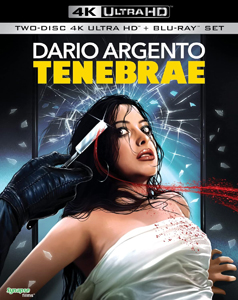If the differences between the elite and the merely interesting Dario Argento films are a surprising ending, next-level kill scenes and pop-psychological underpinnings, “Tenebrae” (1982) achieves that elite standing. We start with a foundation of standard Argento stuff: A successful American mystery novelist (Anthony Franciosa’s Peter Neal) visits Rome, murders begin to happen in his sphere, and he investigates.
“Tenebrae” has more on its mind than is common for a slasher. In an interview soon after he gets off the plane, a female journalist aggressively attacks Neal about the misogyny in his novels. Argento is posing a meta-question, with Neal standing in for himself: By portraying a story of people (mostly women) being slaughtered by a crazed villain (usually a man), is he endorsing that story, and causing harm to society? (Winkingly, it’s suggested that this journalist doesn’t even care. She is angling for alone time with the celebrity.)
Argento presents plenty of food for thought about the role of violence in society, and the way men and women interact in cynical sexual encounters, especially as we reflect on new information about Neal as the movie goes forward. This is one of those films that’s as interesting to analyze as it is to watch.

“Tenebrae” (1982)
Director: Dario Argento
Writer: Dario Argento
Stars: Anthony Franciosa, John Saxon, Daria Nicolodi
It’s a dog-eat-dog world
(SPOILERS FOLLOW.)
In an ending that rivals “Bird with the Crystal Plumage” in surprise factor, Neal is the killer, having offed the original serial killer and then continued the carnage. He aims to murder a lover who has spurned him (although he is not loyal to her either) and have that be credited to the main killer.
Neal has begun to think like a killer because he invents them for his fiction, and the next step is to be a killer. We’re subtly invited to ask if Argento thinks like a killer and is capable of killing. The answer is a dark “yes” to the first one but obviously a “no” to the second. Art and reality are different; intelligent viewers know this. But the Satanic Panic was prevalent in the Eighties, so by even tackling the question, “Tenebrae” is rather daring and certainly timely.
(END OF SPOILERS.)
In the background of some scenes, we see random people fighting – a spousal spat or a bar brawl. While sitting on a city-square bench waiting for his lunch date, Neal’s agent Bullmer (John Saxon, “A Nightmare on Elm Street”) does some people-watching and chuckles at these clashes. It’s perhaps Argento’s commentary on the increasingly violent Eighties, perhaps showing that violence happens independently of horror movies, since these fighters aren’t part of the main plot.
Back in that main plot, the mystery is reasonably foregrounded, but as always Argento cares about experience more so than a tight narrative. The highlight sequence finds young Maria (Lara Wendel) being dropped off by a boyfriend on a dark street corner after a bad date. When walking home, she’s inexplicably chased by a rabid dog. The sequence goes on and on, and somehow the dog gets scarier, as Maria simply can’t escape it.

Keeping us off balance (for better or worse), we know next to nothing about Maria, and this side jaunt seemingly has little to do with Neal nor does it seem to give us answers to the mystery – even though she stumbles into the killer’s lair.
Non-supernatural darkness
One flaw of “Tenebrae” – and it might be my fault – is that the characters (particularly the women) blend together. A couple of them are closely linked to Neal, but others are slasher-movie fodder. As we’re in 1982, the heart of the slasher boom, the American influences start to circle back to giallo films, and these side-character women (and men) tend to be sexually promiscuous.
Also, Argento ups the ante on the kills; particularly impressive is one where a woman gets her arm chopped off and sprays a geyser of blood across a white wall before being finished off with an ax. Because almost everyone is established as self-centered, the kills don’t seem mean-spirited, and I appreciate them for their practical-effects artistry.
That said, “Tenebrae” is gory even by Argento’s standards, inviting us to think about the violence of the times. Even the dream-world cut-ins – featuring a woman who looks much like the Mother of Tears from “Inferno” (because it’s the same actress, Ania Pieroni) – chronicle a stabbing.
Interestingly, Argento’s “Three Mothers” trilogy provides a supernatural answer for its violence, revealing that people are under the sway of Mater Suspiriorum in “Suspiria” and Mater Tenebrarum in “Inferno.” “Tenebrae” is a sort of fake-out final chapter of a “Three Mothers” trilogy, as the title makes us think of Mater Tenebrarum.
However, the actual final chapter would be 2007’s “Mother of Tears,” focusing on the titular Mater Lachrymarum – which makes sense, as she’s the last living member of the trio. In “Tenebrae,” though, the performers of the violence are not under a supernatural sway. Dig into the subtext, if you dare, to find out what motivates them.

